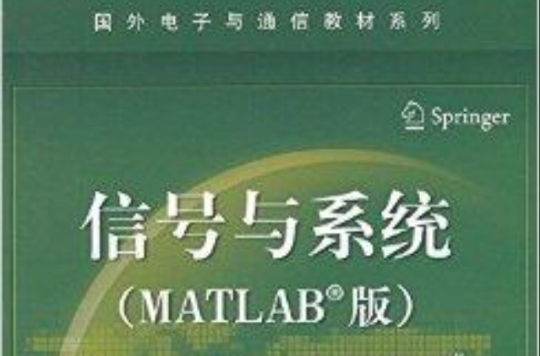基本介紹
- 書名:國外電子與通信教材系列:信號與系統
- 作者:楊(Won Y.Yang)
- 出版社:電子工業出版社
- 頁數:325頁
- 開本:16
- 品牌:電子工業出版社
- 外文名:Signals and Systems with MATLAB
- 類型:計算機與網際網路
- 出版日期:2012年7月1日
- 語種:簡體中文
- ISBN:7121175703, 9787121175701
基本介紹
內容簡介
作者簡介
圖書目錄
1.1 信號
1.2 系統
1.3 由微分∕差分方程描述的系統
1.4 反卷積與相關
1.5 小結
習題
第2章 連續時間傅立葉分析
2.1 周期信號的連續時間傅立葉級數(CTFS)
2.2 非周期信號的連續時間傅立葉變換
2.3 周期信號的(廣義)傅立葉變換
2.4 連續時間傅立葉變換舉例
2.5 連續時間傅立葉變換的性質
2.6 極坐標表示和CTFT的圖形
2.7 小結
習題
第3章 離散時間傅立葉分析
3.1 離散時間傅立葉變換(DTFT)
3.2 離散時間傅立葉變換的性質
3.3 DTFT的極坐標表示和作圖
3.4 離散傅立葉變換(DFT)
3.5 CTFS,CTFT,DTFT和DFT的關係
3.6 快速傅立葉變換(FFT)
3.7 DFT結果的解釋
3.8 信號運算對DFT頻譜的影響
3.9 短時傅立葉變換—譜圖
3.10 小結
習題
第4章 z變換
4.1 z變換的定義
4.2 z變換的性質
4.3 z反變換
4.4 套用z變換分析LTI系統
4.5 z變換的幾何計算
4.6 對稱序列的z變換
4.7 小結
習題
第5章 取樣和重建
5.1 數模(D∕A)轉換
5.2 模數(A∕D)轉換
5.3 取樣
5.4 重建和內插
5.5 取樣保持(S∕H)運算
5.6 小結
習題
第6章 連續時間系統和離散時間系統
6.1 離散時間等效的定義
6.2 輸入回響不變法
6.3 離散化方法
6.4 離散時間等效系統的時間和頻率回響
6.5 s平面極點與z平面極點的關係
6.6 星號變換和脈衝轉移函式
習題
第7章 模擬濾波器和數字濾波器
7.1 模擬濾波器設計
7.2 數字濾波器的設計
7.3 如何使用SP工具(SPTool)
習題
第8章 LTI系統的狀態空間分析
8.1 狀態空間描述—狀態方程和輸出方程
8.2 LTI狀態方程的解
8.3 轉移函式和特徵方程
8.4 連續時間狀態方程的離散化
8.5 狀態空間描述—相似變換
8.6 小結
習題
附錄A 拉普拉斯變換
附錄B 各種變換表
附錄C 複數、向量和矩陣的運算
附錄D 常用數學公式
附錄E MATLAB
附錄F Simulink
參考文獻
MATLAB函式索引
示例索引
注釋索引
編輯推薦
目錄
1.1 What Is a Signal?
1.2 What Is a System?
1.3 Overview of Specific Systems
1.4 Classification of Signals
1.5 Basic Operations on Signals
1.6 Elementary Signals
1.7 Systems Viewed as Interconnections of Operations
1.8 Properties of Systems
1.9 Noise
1.10 Theme Examples
1.11 Exploring Concepts with MATLAB
1.12 Summary
Further Reading
Additional Problems
CHAPTER 2 Time-Domain Representations of Linear Time-Invariant Systems
2.1 Introduction
2.2 The Convolution Sum
2.3 Convolution Sum Evaluation Procedure
2.4 The Convolution Integral
2.5 Convolution Integral Evaluation Procedure
2.6 Interconnections of LTI Systems
2.7 Relations between LTI System Properties and the Impulse Response
2.8 Step Response
2.9 Differential and Difference Equation Representations of LTI Systems
2.10 Solving Differential and Difference Equations
2.11 Characteristics of Systems Described by Differential and Difference Equations
2.12 Block Diagram Representations
2.13 State-Variable Descriptions of LTI Systems
2.14 Exploring Concepts with MATLAB
2.15 Summary
Further Reading
Additional Problems
CHAPTER 3 Fourier Representations of Signals and Linear Time-Invariant Systems
3.1 Introduction
3.2 Complex Sinusoids and Frequency Response of LTI Systems
3.3 Fourier Representations for Four Classes of Signals
3.4 Discrete-Time Periodic Signals: The Discrete-Time Fourier Series
3.5 Continuous-Time Periodic Signals: The Fourier Series
3.6 Discrete-Time Nonperiodic Signals: The Discrete-Time Fourier Transform
3.7 Continuous-Time Nonperiodic Signals: The Fourier Transform
3.8 Properties of Fourier Representations
3.9 Linearity and Symmetry Properties
3.10 Convolution Property
3.11 Differentiation and Integration Properties
3.12 Time- and Frequency-Shift Properties
3.13 Finding Inyerse Fourier Transforms by Using Partial-Fraction Expansions
3,14 Multiplication Property
3.15 Scaling Properties
3.16 Parseval Relationships
3.17 Time-Bandwidth Product
3.18 Duality
3.19 Exploring Concepts with MATLAB
3.20 Summary
Further Reading
Additional Problems
CHAPTER 4 Applications of Fourier Representations to Mixed Signal Classes
4.1 Introduction
4.2 Fourier Transform Representations of Periodic Signals
4.3 Convolution and Multiplication with Mixtures of Periodic and Nonperiodic Signals
4.4 Fourier Transform Representation of Discrete-Time Signals
4.5 Sampling
4.6 Reconstruction of Continuous-Time Signals from Samples
4.7 Discrete-Time Processing of Continuous-Time Signals
4.8 Fourier Series Representations of Finite-Durarion Nonperiodic Signals
4.9 The Discrete-Time Fourier Series Approximation to the Fourier Transform
4.10 Efficient Algorithms for Evaluating the DTFS
4.11 Exploring Concepts with MATLAB
4.12 Summary
Further Reading
Additional Problems
CHAPTER 5 Application to Communication Systems
5.1 Introduction
5.2 Types of Modulation
5.3 Benefits of Modulation
5.4 Full Amplitude Modulation
5.5 Double Sideband-Suppressed Carrier Modulation
5.6 Quadrature-Carrier Multiplexing
5.7 Other Variants of Amplitude Modulation
5.8 Pulse-Amplitude Modulation
5.9 Multiplexing
5.10 Phase and Group Delays
5.11 Exploring Concepts with MATLAB
5.12 Summary
Further Reading
Additional Problems
CHAPTER 6 Representing Signals by Using Continuous-Time Complex Exponentials: the Laplace Transform
6.1 Introduction
6.2 The Laplace Transform
6.3 The Unilateral Laplace Transform
6.4 Properties of the Unilateral Laplace Transform
6.5 Inversion of the Unilateral Laplace Transform
6.6 Solving Differential Equations with Initial Conditions
6.7 Laplace Transform Methods in Circuit Analysis
6.8 Properties of the Bilateral Laplace Transform
6.9 Properties of the Region of Convergence
6.10 Inversion of the Bilateral Laplace Transform
6.11 The Transfer Function
6.12 Causality and Stability
6.13 Determining the Frequency Response from Poles and Zeros
6.14 Exploring Concepts with MATLAB
6.15 Summary
Further Reading
Additional Problems
CHAPTER 7 Representing Signals by Using Discrete-Time Complex Exponentials: the z-Transform
7.1 Introduction
7.2 The z-Transform
7.3 Properties of the Region of Convergence
7.4 Properties of the z-Transform
7.5 Inversion of the z-Transform
7.6 The Transfer Function
7.7 Causality and Stability
7.8 Determining the Frequency Response from Poles and Zeros
7.9 Computational Structures for Implementing Discrete-Time LTI Systems
7.10 The Unilateral z-Transform
7.11 Exploring Concepts with MATLAB
7.12 Summary
Further Reading
Additional Problems
CHAPTER 8 Application to Filters and Equalizers
8.1 Introduction
8.2 Conditions for Distortionless Transmission
8.3 Ideal Low-Pass Filters
8.4 Design of Filters
8.5 Approximating Functions
8.6 Frequency Transformations
8.7 Passive Filters
8.8 Digital Filters
8.9 FIR Digital Filters
8.10 IIR Digital Filters
8.11 Linear Distortion
8.12 Equalization
8.13 Exploring Concepts with MATLAB
8.14 Summary
Further Reading
Additional Problems
CHAPTER 9 Application to Linear Feedback Systems
9.1 Introduction
9.2 What Is Feedback?
9.3 Basic Feedback Concepts
9.4 Sensitivity Analysis
9.5 Effect of Feedback on Disturbance or Noise
9.6 Distortion Analysis
9.7 Summarizing Remarks on Feedback
9.8 Operational Amplifiers
9.9 Control Systems
9.10 Transient Response of Low-Order Systems
9.11 The Stability Problem
9.12 Routh-Hurwitz Criterion
9.13 Root Locus Method
9.14 Nyquist Stability Criterion
9.15 Bode Diagram
9.16 Sampled-Data Systems
9.17 Exploring Concepts with MATLAB
9.18 Summary
Further Reading
Additional Problems
……
CHAPTER 10 Epilogue
APPENDIX A Selected Mathematical Identities
APPENDIX B Partial-Fraction Expansions
APPENDIX C Tables of Fourier Representations and Properties
APPENDIX D Tables of Laplace Transforms and Properties
APPENDIX E Tables of z-Tansforms and Properties
APPENDIX F Introduction to MATLAB
INDEX

